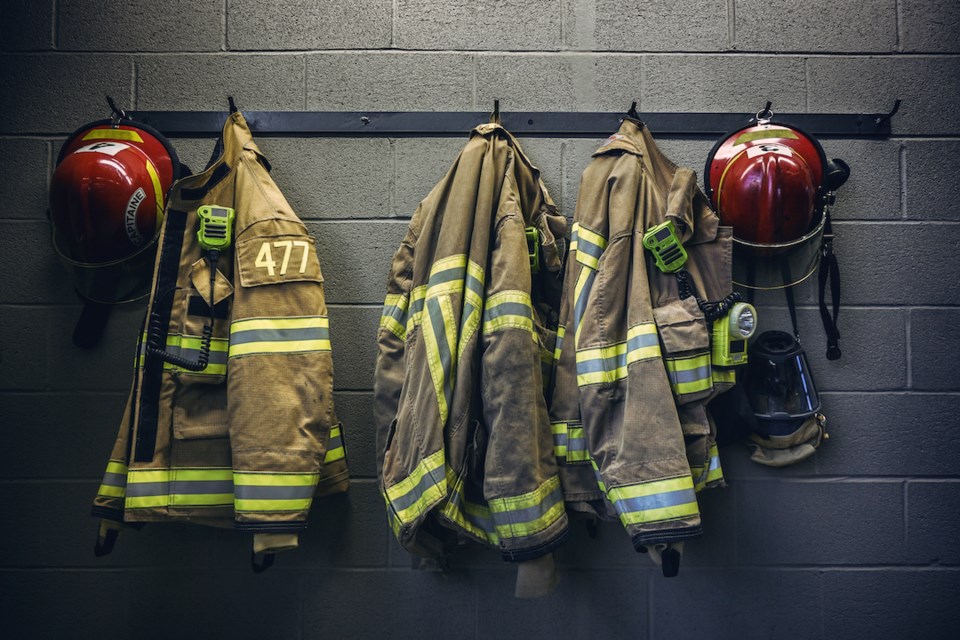Firefighters battle more than flames: cancer is the leading cause of death among firefighters and January marks Firefighter Cancer Awareness Month.
Over 75 per cent of firefighter fatalities are directly associated with cancer, according to Ken McMullen, president of the Canadian Association of Fire Chiefs (CAFC). Specifically, the illnesses are often presumptive cancers – occupational diseases presumed to occur due to the nature of a worker's employment as a firefighter or fire investigator.
There are over 126,000 firefighters in Canada and roughly 80 per cent of these are volunteers, McMullen said. On the Sunshine Coast, there are more than 200 firefighters across six local fire departments. Most of them are volunteers.
Among the four departments operated through the Sunshine Coast Regional District (SCRD), there are 130 firefighters: 50 in Gibsons, 30 in Roberts Creek, 32 in Halfmoon Bay, and 18 in Egmont. Pender Habour Volunteer Fire Department has 36 firefighters between its two halls. And the Sechelt Fire Department currently has 36 members.
McMullen said that firefighter cancer awareness has gained some attention over recent years, largely due to the unfortunate reality of people losing their lives.
He said CAFC believes that in 2022 and 2023, 40 people died in Canada from cancers that were related to firefighting.
However, not every province recognizes the same types of cancers as being presumptive.
This means that firefighters may not receive the same level of support in case of a given illness in one province that they would in another.
A federal act passed last June hopes to fix that with the creation of a National Firefighters Cancer Framework for preventing and treating cancers linked to firefighting, as explained in the act’s preamble.
Now, organizations such as CAFC are working with Health Canada to complete the framework, which will include educating doctors and healthcare professionals to understand symptoms and the types of tests to run on firefighters.
“We need to raise that federally and say that there are two or three tests that we think that all firefighters should be given annually if they're a volunteer, paid-on-call or a career firefighter," McMullen said.
Cancer on the Coast
Fire departments on the Sunshine Coast are keenly aware of presumptive cancers.
In November 2022, Andre Dube a retired Roberts Creek volunteer firefighter of 38 years, died from presumptive cancer. The department honoured him with a Line of Duty Memorial Service at the Roberts Creek Community Hall the following February. “Andy was a true hero, dedicating his life to protecting and serving the community with unwavering dedication and commitment,” a post on the fire department’s Facebook page read. Dube’s name was also added to the national Canadian Fallen Firefighter Foundations Memorial in Ottawa last September.
Pat Higgins, Roberts Creek Volunteer Fire Department fire chief shared that another one of their retired firefighters was diagnosed with leukemia, which is on the list of presumptive illnesses.
“WorkSafe did accept his claim, and so he's getting good support from WorkSafe BC,” said Higgins.
Given the dangers of the job, prevention and safety are top of mind for local departments.
One way the Roberts Creek fire department sees firefighters protected is by limiting their exposure to harmful chemicals.
Water-resistant chemicals called per- and polyfluoroalkyl substances (PFAS) are used in the inner liner of firefighter turnout gear, which firefighters wear to attend structure fires. PFAS are recognized as carcinogenic.
Firefighters only use turnout gear on structure fires as opposed to medical calls, rescues or wildland firefighting, Higgins explained.
He added that one of the department's suppliers now provides sets of structural turnout gear that are PFAS-free, however, each set costs $6,000, instead of the $3,500 cost of the current gear.
Dwight Davison, Sechelt Fire Department’s acting fire chief, said that while no one in his department has had to file a presumptive cancer claim, the department recognizes that firefighters are exposed to cancer-causing chemicals at every fire they attend. One way they support them is through thorough decontamination procedures.
“We're working hard to get all of our people to rinse off their gear and wash up before they get back on the fire trucks – not putting it back in the cabs and exposing ourselves again, " Davison said. “We've got special body wipes that we use on our hands and face and neck to help wipe the toxins off of the exterior of the skin so that they're not absorbed.”
He added that the skin around the neck is 300 per cent more susceptible to absorption of hazardous chemicals.
Davison said that firefighter health measures are an ongoing process.
“The more that we learn, the more we can bring forward to our firefighters,” he said. “We're trying to create the safest environment we can for them, and for all of them to have long careers here where they can enjoy their lives after the fire service as well.”
Jordan Copp is the Coast Reporter’s civic and Indigenous affairs reporter. This reporting beat is made possible by the Local Journalism Initiative.



